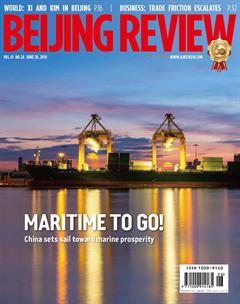Cosmic Observation

An observatory for detecting cosmic rays under construction in southwest Chinas Sichuan Province. The project, known as LHAASO, is located in the mountains at the eastern edge of the Qinghai-Tibet Plateau at an average altitude of 4,410 meters.
Blood Donations
The number of voluntary blood donations in China reached nearly 5.97 million in the fi rst fi ve months of this year, up 3.6 percent year on year, according to the countrys National Health Commission.
The amount of blood donated hit 2,065 tons during the same period, marking a 5.2-percent increase.
The number of voluntary blood donations has seen 20 years of consecutive growth, from 328,000 in 1998 to 14.59 million in 2017, fi gures from the commission showed.
Thanks to a system for more rational clinical use of blood, China has managed to reduce the amount used for each patient and clinical operation by 20 percent and 30 percent on average in the past fi ve years, the fi gures showed.
Charity Project
A China Foundation for Poverty Alleviation project has raised nearly 21 million yuan ($3.3 million) in donations and aided 120,000 children since 2014, the foundation said.
The project was launched in 2014 with the aim of helping children in impoverished areas to develop. The organizers mobilized 16,000 people to trek 50 km, with more than 223,000 people making donations.
The donations have been used to provide stationery, clothes and art equipment to more than 32,000 children, as well as building 146 kitchens in schools to provide better meals for 60,000 students.
The project also employed“companion mothers” to care for more than 30,000 rural children whose parents have left home to seek work in the cities.
Convicting Terrorism Offenses
Chinas judiciary issued a document on June 15 to clarify what actions constitute assisting terrorists, preparing for terrorist activity and advocating terrorism.
The Supreme Peoples Procuratorate (SPP), the Supreme Peoples Court (SPC), the Ministry of Public Security and the Ministry of Justice issued a document on practical standards for judges and prosecutors to identify new crimes of terrorism introduced by a revision to the Criminal Law in 2015, and regulate prosecuting procedures.
People who donate, sell their property to sponsor terrorist groups, or provide equipment, transportation or weapons to terrorists, are now considered to be assisting terrorist activities.
Those helping with recruitment or border crossings are also guilty of assisting terrorists.
People, who produce, purchase, store and transport explosives and other hazardous substances for terrorist attacks, organize training face to face or online, take part in such training or make contact with overseas terrorist groups, will be convicted of preparing for terrorist activities.
People, who compile, publish, print, copy, distribute and broadcast publications, audio and video products containing terrorist and extremist ideologies, will be convicted of advocating terrorism and extremism and inciting terrorist activities.
Actions leading to conviction also include using websites and social media to publish and display such publications and videos.
The document stressed that a person, who owns documents and videos below the criminal standard, can still be convicted of illegal possession if he or she is a multiple offender or has been convicted of terrorism offenses within the past two years.
Campaign Against Pornography
Chinese authorities have begun a campaign to crack down on Web novels with vulgar or obscene content, delivering improper ideas to the public, or involved with copyright infringement.
The campaign, jointly launched by the State Administration of Press and Publication and the National Off cie Against Pornographic and Illegal Publications, began in May and will run until August.
It will also shut down websites and apps that go against basic moral values or are incapable of proper operation, according to a news conference on June 14.
The two authorities, in coordination with other departments, have already closed more than 400 websites in China and overseas that violated laws and regulations.
Returning Home
More overseas Chinese professionals are returning to China as the countrys tech-oriented economic transition offers abundant career development opportunities, a recent report showed.
The percentage of overseas Chinese professionals aged between 30 and 40 years old among returning Chinese rose from 16.5 percent in 2013 to 30.6 percent in 2017, according to a report released by global employment-oriented social networking platform LinkedIn.
The report attributed the increasing numbers of overseas Chinese professionals returning to the limits on career development in foreign countries and showed that these professionals enjoy marked title and pay rises as Chinese fi rms invest more to attract top talent to help drive business growth.
In addition to fi rst-tier cities like Beijing and Shanghai, emerging fi rst-tier cities like Hangzhou and Chengdu are popular destinations for overseas Chinese professionals to develop their careers, the report pointed out.
The fi nance and technology sectors have attracted the largest number of these people, who prefer to work in multinational and large and mediumsized private companies.
A lack of understanding of the working environment in Chinese fi rms is the top concern for overseas Chinese professionals seeking opportunities in the country, the report showed.
Preserving Tradition
A Kunqu Opera puppet show is performed during a four-day cultural heritage festival in Nanjing, capital of east Chinas Jiangsu Province, on June 15. Ancient cultural heritage was on display at the festival to draw peoples attention to traditional cultural practices whose future is uncertain.
Less Solid Waste
Chinas imports of solid waste dropped signifi cantly in the fi rst quarter of this year as the government steps up its enforcement of a ban on solid waste imports.
There was a 57-percent yearon-year decline in the amount of solid waste imports in the fi rst three months, and 64 percent for restricted categories, according to the Ministry of Ecology and Environment. The fi gures increased from 9.2 percent and 12 percent last year, respectively.
The ministry said it will step up scrutiny over import licenses and crack down on violations of environmental protection laws by waste processing factories, striving to maintain the downturn in waste imports.
China began importing solid waste as a source of raw materials in the 1980s, and has for years been the worlds largest importer, despite its weak capacity for garbage dispos- al. Some companies illegally bring foreign garbage into the country for profi t, posing a threat to the environment and public health.
Given rising public awareness and a green development drive, the government decided last year to phase out and completely halt such imports by the end of 2019, except for those containing resources that are not substitutable.
Chinas customs authority seized 137,000 tons of illegal trash imports in May in what it called the largest campaign against trash smuggling in recent years.
Li Ganjie, Minister of Ecology and Environment, said the ban on foreign rubbish is a major step to improve the environment, safeguard national ecological security and follow the green development strategy.
Stretching Out
People practice yoga at a wetland park in Wuxi, east Chinas Jiangsu Province, on June 16. Thousands of enthusiasts participated in the activity as part of the international yoga festival that kicked off that day.
Googles JD Investment
Chinese e-commerce giant JD.com announced on June 18 that it had secured investment worth $550 million from Google as part of a new strategic partnership between the two leading tech companies.
Google will obtain around 27.1 million newly-issued, Class-A, ordinary shares in JD.com at an issue price of $20.29 per share.
The two companies will jointly explore the retail business in regions around the world, including Southeast Asia, the United States and Europe. The cooperation will combine JD.coms advantages in supply chain and logistics and Googles technology strengths.
JD.com also plans to make a selection of products available for sale through Google Shopping in multiple regions.
“This partnership with Google opens up a broad range of possibilities to offer a superior retail experience to consumers around the world,” said JD.coms Chief Strategy Offi cer Liao Jianwen.
Better Connected
The Yellow River Bridge of the Yuncheng-Lingbao Expressway under construction in Yuncheng, north Chinas Shanxi Province on June 19. The closure of the 1,690-meter bridge was fi nished that day.
The bridge is a key part of the route connecting Shanxi and Henan provinces and a vital section of the Hohhot-Beihai highway network. The bridge is being built using a two-way, six-lane design, with the project expected to be fi nished in October.
Xiaomi CDR Postponed
Xiaomi has decided to fi rst offer shares in Hong Kong and then issue China Depositary Receipts (CDR) at a proper time, the company announced on June 19.
The China Securities Regulatory Commission (CSRC), the countrys top securities regulator, said it respects Xiaomis decision and would cancel its schedule to review the prospectus fi led by Xiaomi on June 19.
Xiaomi fi rst fi led its prospectus to the commission on June 7 and later updated it on June 14, after which the commission disclosed its lengthy feedback in the form of 84 classifi ed questions.
The concerns primarily relate to Xiaomis licenses for online business, its ecosystem companies, risk disclosure, shareholding structure and research and development.
Earlier this month the CSRC issued rules on a test run of the issuance and trading of CDRs.
The rules, which became effective when issued, lay the institutional foundation for innovative fi rms to issue CDRs in the mainland capital markets.
Xiaomi is the fi rst company to fi le a prospectus for issuing CDRs.
New Negative List
China has completed the revision of a new negative list for the market access of foreign investment and will make it public soon, China Securities Journal reported on June 19.
Restrictions on energy, resources, infrastructure, transportation, commerce circulation, and professional services will be removed or loosened in the new list, according to the report.
The new negative list will have two sections, one for nationwide implementation and one for pilot free trade zones, it reported.
Besides opening-up measures in 2018, the new negative list will unveil further measures for the next few years and there will be a transitional period for some industries.
Stable Home Prices
Home prices in major Chinese cities remained largely stable in May as local governments toughened restrictions to prevent speculation, offi cial data showed on June 15.
On a yearly basis, new residential housing prices in four fi rsttier cities declined 0.6 percent from a year ago last month, the fourth straight decline, the National Bureau of Statistics (NBS) said in a statement. Prices of existing homes dropped for three consecutive months at 0.2 percent.
Meanwhile, home prices in 35 third-tier cities were cooler. There was a slowdown in price growth for four months in a row in new houses, and for 10 months in existing ones.
“The majority of cities saw an ongoing year-on-year downturn or deceleration of growth in home prices,” NBS senior statistician Liu Jianwei said. The statistics authority tracks the property markets of 70 major cities including Beijing and Shanghai.
Liu noted that new home prices declined year on year in eight of the 15 hotspot cities, where speculative home purchases are specifi cally monitored, with the biggest price drop of 2.8 percent last month, while seven other cities posted growth.
Bucking the trend, 31 secondtier cities witnessed faster home price increases.
During previous years, rocketing housing prices, especially in major cities, had fueled concerns about asset bubbles. To curb speculation, local governments imposed or expanded their restrictions on house purchases and increased the minimum down payment required for a mortgage.
The government is also working on a long-term mechanism for property regulation that will ensure sustainable and stable development of the real estate market, or simply put a basket of policies ranging from home-leasing and affordable housing to a new tax on home ownership.
Non-financial ODI
Non-fi nancial outbound direct investment (ODI) continued to see strong growth in the fi rst fi ve months of 2018, according to data from the Ministry of Commerce.
Domestic investors made$47.89 billion of non-fi nancial ODI in 2,987 overseas companies across 149 countries and regions between January and May, up 38.5 percent year on year.
Gao Feng, the ministrys spokesperson, said the countrys structure of outbound investment continued to improve, with investment mainly going into the sectors of business and rental services, mining, manufacturing, retail and wholesale.
ODI into 54 economies related to the Belt and Road Initiative rose 8.2 percent year on year to $5.93 billion during the fi rst fi ve months.
From a long-term perspective, experts warned that Chinese companies eyeing overseas expansion in both developed and emerging economies need to share risk information and unite to build a riskprevention system.
“New issues, including trade disputes between the United States and many countries, the United Kingdoms impending withdrawal from the European Union, and some nations changing attitude toward Chinese investment, especially Australia, mean that Chinese companies need to take precautions before entering foreign markets,”said Xue Rongjiu, Deputy Director of the Beijing-based China Society for WTO Studies.
Root and Branch
The residents of a village in Luanxian County, north Chinas Hebei Province, trim saplings on June 19. Local residents have focused on tree farming in recent years, with their incomes increased and the environment improved.
Expanding Network
A bullet train runs through Nanning, south Chinas Guangxi Zhuang Autonomous Region, on June 18. The total length of operational high-speed railway tracks in Guangxi has hit 1,751 km from zero in just fi ve years. By 2020, the autonomous region expects to expand its high-speed railway network to over 2,000 km.
Innovation Ties
Shenzhen, south Chinas Guangdong Province, hosted an event in Silicon Valley on June 18 to seek pragmatic collaboration with the birthplace of U.S. digital innovation.
Shenzhen and Silicon Valley can leverage each others advantages in infrastructure and service-related conditions to foster collaborative innovation and create synergy, said Wang Weizhong, secretary of the Communist Party of Chinas Shenzhen Municipal Committee.
He made the remarks at the“China Shenzhen-U.S. Silicon Valley Investment Collaboration and Exchange Conference” hosted by the Shenzhen Municipal Government in Santa Clara, California.
Last year, Shenzhens GDP reached $330 billion, making it Chinas third largest city in terms of economic size. It has produced seven Fortune Global 500 enterprises and 14 unicorn companies, according to Wang.
So far, 280 Fortune Global 500 companies have invested in Shenzhen and its number of listed companies has surpassed 380.
“Silicon Valley is the worlds capital of innovation. It has impacted the development of global tech,”Wang said. “Shenzhen will help innovators in Silicon Valley to transform their technologies into products at the fastest possible speed.”

